a complex introduction to the first record of E. ciodes ciopsis in South Korea

Photo © Nial Moores
Although there are twenty Emberiza bunting species on the South Korean list, only two of these are fairly widespread and present throughout the year: the rather numerous Yellow-throated Bunting E. elegans and the much more local Meadow Bunting E. ciodes.
In South Korea at least, the Meadow Bunting’s name appears to be something of a misnomer, as the species is not associated with meadow grasslands, being instead largely confined to patches of reeds with bushes in river channels (especially in the southern lowlands in winter), and to secondary growth on hill slopes, often where there are dense stands of pine. Resident in fairly well-defined territories in many areas, it is also apparent that local populations are augmented by migrants, especially in the north of the country where flocks of 40 or 50 are sometimes noted in mid-winter. The origin of many of these migrants appears likely to be North Korea (and bordering regions), especially as Tomek (2002) states that the Meadow Bunting is a common breeding species observed throughout the DPRK, forming flocks of up to a hundred individuals during migration and in winter.

Note the "large-billed" look; the chestnutty-orange ear coverts (close in saturation to the intensely colored breast patch); the whitish throat, and soft grey neck sides of this rather worn bird. The largely unstreaked mantle and plain-looking scapulars (lacking obvious darker centres) seem "good" for castaneiceps.
According to Byers, Olsson and Curson (1995) the subspecies of Meadow Bunting occurring in East China and in Korea should be castaneiceps, an observation largely supported by Tomek’s research into the specimen record in DPRK. Tomek (2002) notes that earlier authors consider that castaneiceps nests on the Korean peninsula and that the slightly larger (and paler) weigoldi (nesting in SE Siberia and NE China) also winters here, but she instead asserts that the measurements of specimens in DPRK suggest all specimens fall within the range presented by Vaurie for both subspecies: i.e. they cannot be determined to subspecies on measurements alone (and could therefore all be castaneiceps).
The assumption that Meadow Buntings, at least in the south of the Korean peninsula, are also castaneiceps is, however, greatly complicated by at least two factors. The first is that there are obvious differences in appearance between the description and illustrations of breeding plumaged male castaneiceps given in Byers, Olsson and Curson (1995), and many (but not all) breeding-plumaged males seen in South Korea; the second is that birds on the south coast, and most especially on Jeju Island, appear further to show some mixed characters between this widespread mainland type and the comparatively isolated and strikingly-plumaged ciopsis subspecies, which nests throughout most of Japan. Add to this the presence of obviously pale individuals in winter in more northern areas of South Korea, and also the record (described below) of a ciopsis male that apparently wintered on the Guryongpo Peninsula on the east coast (2002/2003), and it is clear that the taxonomic situation of Meadow Bunting in South Korea (and on the Korean peninsula) is far from straightforward.
Before further discussion and illustration of three of the four Meadow Bunting types found in South Korea (the "paler type" sometimes observed in winter and considered by earlier authors in DPRK to be wiegoldi falls outside of the scope of this note, due to possible misidentification of well-marked females and non-breeding plumaged males), it seems appropriate to list some key identification points of the distinctive adult breeding males of three main subspecies, as summarised by Byers, Olsson and Curson (1995):
Nominate cioides (Altai to Transbaikalia and Mongolia): chestnut crown and ear-coverts, and prominent breast band. Streaked mantle separates from castaneiceps.
castaneiceps (East China, Korea): mantle almost uniformly chestnut; breast-band broader than nominate.
ciopsis (Japan): Ear-coverts black. Often blackish blotches on breast. Bill longer and more slender than other races.
"Korean Meadow Bunting" Emberiza ciodes (castanieceps)

This individual, although worn, still shows fairly apparent mantle streaking. The ear coverts appear darker than in the field, due to the angle of the head. Note also the heavy bill, quite long primary projection, dark grey neck sides, and how the dark on the lores reaches to the bill base, in a rather narrow point.
Typical male Meadow Bunting in the breeding season in South Korea show chestnut-brown ear-coverts (often with an almost orangey tone), contrasting with a very broad and even flared white supercilium, a chestnut-crown, often with a paler central crown stripe, and in many/most cases, clear dark mantle streaking on a warm brown background. Somewhat puzzlingly, some males (as in Figure 1 above) show much more strongly chestnut mantles, with only faint streaking, better matching Byers et al. description of castaneiceps. The neck sides show some grey, and the throat too is washed lightly grey, though appearing whitish at range. The bill is large, and the culmen appears convex. The underside of the tail invariably appears largely white. Some of the calls are rather deeper and less sharply metallic than the equivalent calls given by ciopsis.
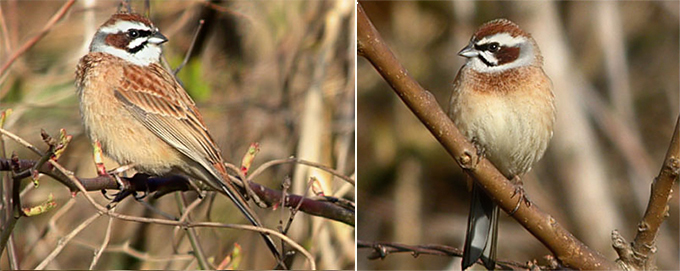
Both show the range of features typical of most "Korean Meadow Buntings".

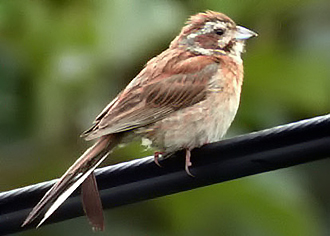
Females show rather more variable head-patterns than males, with some looking quite male-like, and others lacking the darker lores and showing a rather more open-looking "face". Note again the very heavy-looking bill and the reasonably long primary projection.
Females appear broadly similar, as washed-out versions of non-breeding males, also with white undersides to the closed tail.
This is the form that occasionally appears on migration in Japan, where it is known as "Choosen Hoojiro", or "Korean" Meadow Bunting, occurring annually e.g. in Fukuoka Prefecture, some 200 km south of the Korean peninsula (pers. obs.).
"Japanese Meadow Bunting" Emberiza cioides ciopsis
There is only one record known to Birds Korea of this taxon: a male that was found and photographed at Daebo, the Guryongpo Peninsula, on November 23rd 2002, with presumably the same individual heard and seen briefly in the same area on April 6th, 2003 (both Nial Moores). Most obvious differences from "Korean Meadow Bunting of the Guryongpo bird (and numerous males seen in Japan annually since 1990), include the blackish ear-coverts (washed with chestnut to the rear in non-breeding males), the more obviously orangey-rufous saturated underparts and contrasting rump; the deeper grey neck sides and the more obvious grey wash on the throat.
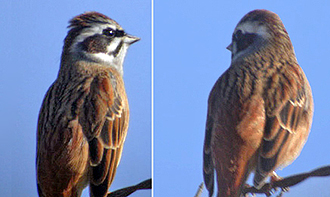
This small-billed, warmly-colored individual shows the blackish ear-coverts (with limited brown to the rear), grey-washed throat, solidly black lores extending up onto the forehead sides, and rather blunter-looking primaries typical of ciopsis or "Japanese Meadow Bunting".
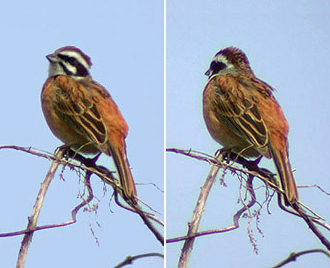
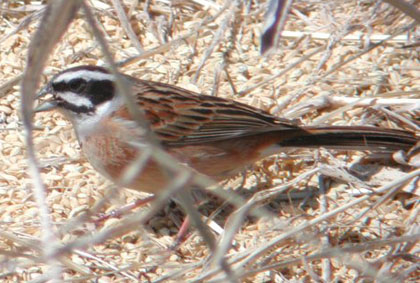
Photo © Bill Hull (http://www.mangoverde.com/birdsound)
In these two males (one from southwestern Japan, one from central Honshu), note the compact look, with blunter-looking primaries and a shorter primary projection than birds typically found in Korea. There seems to be a tendency for males in Japan to inflate their rump feathers prominently when sitting or singing from an exposed perch, behaviour which does not appear to be so prevelant in birds in South Korea.
In addition to having an obviously slimmer bill (with a flat or even very slightly concave upper mandible), this taxon also seems to show the most dark in the underside to the closed tail, and a subtly different facial pattern, with a shorter ’sub-moustachial’ stripe, more diamond-shaped than in Korean birds, and perhaps more obviously blocked off by dark feathering running from the ’malar’ stripe across to the bottom end of the ’moustachial’ (as Byers et al note, these feather tracts do not quite correspond with the same tracts shown more clearly by many other species). Interestingly too, the "jit-jit-jit" contact call is decidedly sharper and more metallic than the same call given by Korean birds: the difference was striking enough to allow the Guryongpo individual to be relocated on call alone, even when in a loose flock with 5 or 6 "Korean" Meadow Bunting. Many ciopsis also appear in the field to have more rounded primaries with less of a primary projection beyond the longest tertial than Korean birds - possibly a reflection of the largely non-migratory behaviour of most "Japanese Meadow Bunting".
Occupying a much broader range of habitats than birds in much of Korea, this "very common and widely distributed" taxon is largely a summer visitor to Hokkaido, having also occurred as a winter "rarity" as far south as Okinawa (Brazil, 1991), and peaking on offshore islands in southwestern Japan in November and again in March (pers. obs). suggesting that at least some individuals undertake regular and significant seasonal movements.
"Jeju Meadow Bunting"
The southern coast of the Korean peninsula, including the large, isolated volcanic island of Jeju (centred at very approximately 33 D 00 N and 126 D 35 E), and the northern coast of Kyushu (the southerNial Mooresost main island of Japan) both lie above the 15 C mean annual temperature isotherm, and within the wet summer monsoon zone, and perhaps largely as a consequence, seem to share rather similar plant and bird communities. Both Kyushu and Jeju Island share for example widespread nesting Japanese White-eye of the subspecies japonica, the japonensis subspecies of Large-billed Crow [Howard and Moore, 1984]) and nesting cantans Japanese Bush Warbler.

Sexing of female based on apparent pairing with the singing male on the left, as well as the obviously paler ear-coverts (contrasting with black lores), and the much less saturated coloration overall, lacking completely the richer-colored more mottled-looking breast band of a spring male.

This singing male shows an obviously paler central crown stripe and heavily streaked mantle typical of Meadow Buntings on Jeju (and in Japan), but much browner ear coverts, more restricted black on the lores, and a rather more flared supercilium, more typical of birds found on the Korean mainland.
Especially on Jeju Island (and most especially in the southwestern part of that island), Meadow Buntings are also both numerous and rather visible, singing not only from the tops of walls, grasses and small pines, but also even from telephone wires next to busy roads: unusual behavior for mainland "Korean Meadow Bunting", but behaviour clearly recalling ciopsis Meadow Bunting in Japan.
In addition, singing males seem to exhibit coloration intermediate between ciopsis and mainland "Korean Meadow Bunting", with rather dark ear coverts (appearing blackish, but still with a clear chestnut wash lacking in breeding ciopsis), often also with a faint dark line defining the sub-coronal stripe, a clearly paler center to the browner crown, and more obvious mantle stripes.
Although first noted by the author in 1998 both on Jeju and less obviously at two or three mainland sites on the south coast (the westerNial Mooresost being near Suncheon Bay, at approximately 34 D 50 N, 127 D 32 E), subsequent visits to Jeju have been too short or limited in focus to investigate whether these differences are consistent either throughout the island or along the south coast (which might suggest perhaps some historic zone of hybridization or intergrade between ciopsis and "Korean" Meadow Buntings ) or whether individuals exhibit a random and broad range of intermediate characteristics, suggesting perhaps contemporary mixing of resident birds with occasional migrants of different origins.
Summary
It is clear that many of the Meadow Buntings nesting in South Korea exhibit some differences from those described in Byers, Olsson and Curson (1995) for the subspecies castaneiceps; it is also clear that populations in the far south of the country show differences from birds breeding further north. Although it is possible that such variation has already been thoroughly investigated and described by Korean researchers (with their findings perhaps remaining inaccessible in unpublished research reports), it seems likely that much greater research into the Meadow Bunting complex both here and in Japan would allow for a rather fuller and more accurate description of the various subspecies and their relationships - perhaps even allowing for a reassessment of ciopsis at the species level.
We would very much welcome receiving informed opinion from anyone with experience of Meadow Bunting, particularly photographs of breeding-plumaged males, and if possible details on measurements and vocalizations.
We would also like to thank both Atle Ivar Olsen and Bill Hull (http://www.mangoverde.com/birdsound) for permission to use their images.
References:
- Brazil, M. (1991). The Birds of Japan. Helm Publications.
- Byers, C., Olsson, U., & J. Curson. (1995). Buntings and Sparrows. A Guide to the Buntings and North American Sparrows. Pica Press publication.
- Howard, R., & A. Moore. (1984). A Complete Checklist of the Birds of the World. Second edition.
- Tomek, T. (2002). The birds of North Korea. Passriformes. Acta zool. Cracov. 45 (1): 1-235.



